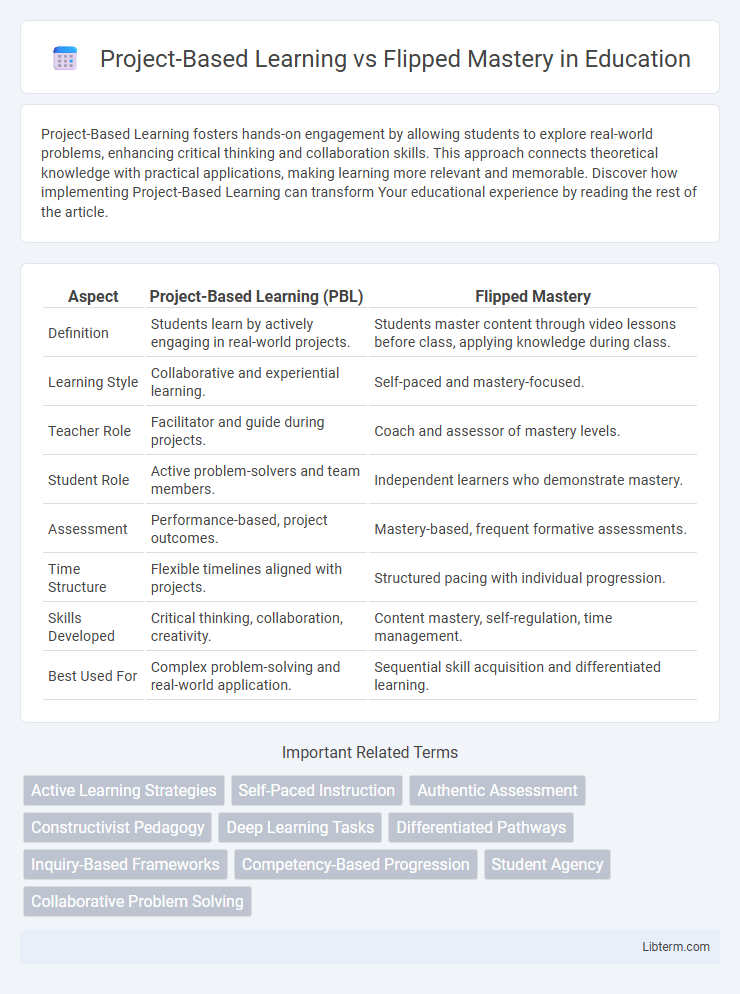Project-Based Learning fosters hands-on engagement by allowing students to explore real-world problems, enhancing critical thinking and collaboration skills. This approach connects theoretical knowledge with practical applications, making learning more relevant and memorable. Discover how implementing Project-Based Learning can transform Your educational experience by reading the rest of the article.
Table of Comparison
| Aspect | Project-Based Learning (PBL) | Flipped Mastery |
|---|---|---|
| Definition | Students learn by actively engaging in real-world projects. | Students master content through video lessons before class, applying knowledge during class. |
| Learning Style | Collaborative and experiential learning. | Self-paced and mastery-focused. |
| Teacher Role | Facilitator and guide during projects. | Coach and assessor of mastery levels. |
| Student Role | Active problem-solvers and team members. | Independent learners who demonstrate mastery. |
| Assessment | Performance-based, project outcomes. | Mastery-based, frequent formative assessments. |
| Time Structure | Flexible timelines aligned with projects. | Structured pacing with individual progression. |
| Skills Developed | Critical thinking, collaboration, creativity. | Content mastery, self-regulation, time management. |
| Best Used For | Complex problem-solving and real-world application. | Sequential skill acquisition and differentiated learning. |
Introduction to Project-Based Learning and Flipped Mastery
Project-Based Learning (PBL) engages students in real-world projects, fostering critical thinking, collaboration, and problem-solving skills through hands-on experiences. Flipped Mastery inverts traditional teaching by delivering instructional content online outside of class, allowing students to learn at their own pace and demonstrating mastery before moving on. Both approaches emphasize student-centered learning but differ in their delivery and assessment methods, with PBL focusing on collaborative projects and Flipped Mastery emphasizing individualized content mastery.
Core Principles of Project-Based Learning
Project-Based Learning (PBL) centers on student-driven projects that encourage critical thinking, collaboration, and real-world problem solving, emphasizing inquiry and hands-on experience. Core principles include sustained inquiry, authenticity of the task, student voice and choice, reflection, critique, and revision, fostering deep understanding through active engagement. Unlike Flipped Mastery, which focuses on self-paced mastery of content via videos and practice, PBL immerses learners in complex challenges requiring interdisciplinary knowledge and teamwork.
Core Principles of Flipped Mastery
Flipped Mastery centers on personalized learning where students progress at their own pace by demonstrating mastery of content before moving forward, emphasizing mastery checkpoints and self-directed study. Core principles include formative assessments, tailored instructional videos, and a classroom environment that supports collaboration and individualized support. Unlike Project-Based Learning, which focuses on real-world projects and teamwork to build skills, Flipped Mastery prioritizes mastery of discrete skills through a flipped instructional model.
Key Differences Between Project-Based Learning and Flipped Mastery
Project-Based Learning emphasizes collaborative, hands-on projects that integrate real-world problem-solving with subject knowledge, allowing students to develop critical thinking and teamwork skills over extended periods. Flipped Mastery focuses on individual learning where students progress at their own pace by mastering content through video lectures and exercises before applying knowledge in class activities. Key differences include PBL's emphasis on group collaboration and real-world context versus Flipped Mastery's personalized pacing and mastery of discrete skills prior to application.
Student Engagement and Motivation
Project-Based Learning (PBL) enhances student engagement by immersing learners in real-world problems, fostering collaboration and critical thinking through hands-on activities. Flipped Mastery promotes motivation by allowing students to control the pace of their learning, providing personalized feedback and mastery checks that build confidence and competence. Both approaches increase active participation but differ in structure, with PBL centered on extended projects and Flipped Mastery emphasizing self-paced, video-based instruction followed by mastery demonstrations.
Role of Teachers in Each Approach
In Project-Based Learning, teachers act as facilitators who guide students through complex, real-world projects, fostering collaboration, critical thinking, and problem-solving skills. In Flipped Mastery, teachers serve as personalized coaches, providing tailored support and feedback as students progress through mastery-based content at their own pace. Both approaches emphasize active teacher involvement, but Project-Based Learning prioritizes mentorship in open-ended inquiry, while Flipped Mastery focuses on individual skill mastery and immediate remediation.
Assessment Methods Compared
Project-Based Learning (PBL) employs formative and summative assessments through real-world project completion and peer evaluations, emphasizing practical skill application and collaboration. Flipped Mastery assessment centers on mastery checkpoints, quizzes, and personalized feedback, ensuring students demonstrate proficiency before advancing. Both models prioritize continuous assessment but differ in approach: PBL integrates assessment within projects, while Flipped Mastery focuses on modular, mastery-based evaluation.
Technology Integration in Both Models
Project-Based Learning (PBL) leverages technology tools like collaborative platforms, digital research databases, and multimedia presentations to facilitate real-world problem-solving and teamwork. Flipped Mastery integrates adaptive learning software, video tutorials, and learning management systems to personalize instruction and allow students to progress at their own pace. Both models utilize technology to enhance engagement and provide differentiated learning experiences, with PBL focusing on interactive creation and Flipped Mastery emphasizing self-directed mastery of content.
Challenges and Limitations
Project-Based Learning (PBL) faces challenges such as uneven student participation, time-intensive planning, and difficulty assessing individual contributions within group projects. Flipped Mastery requires reliable technology access and self-discipline from students, which can be limiting in under-resourced environments and for learners needing more direct guidance. Both methods can struggle with scalability and may demand significant teacher training to implement effectively.
Choosing the Best Approach for Your Classroom
Project-Based Learning engages students through hands-on, real-world projects that foster collaboration and critical thinking, ideal for classrooms emphasizing creativity and teamwork. Flipped Mastery allows students to learn foundational content at their own pace through videos and digital resources, promoting individualized learning and mastery before applying knowledge in class. Selecting the best approach depends on your classroom goals, student needs, and subject matter, balancing autonomy with interactive, project-driven experiences.
Project-Based Learning Infographic

 libterm.com
libterm.com